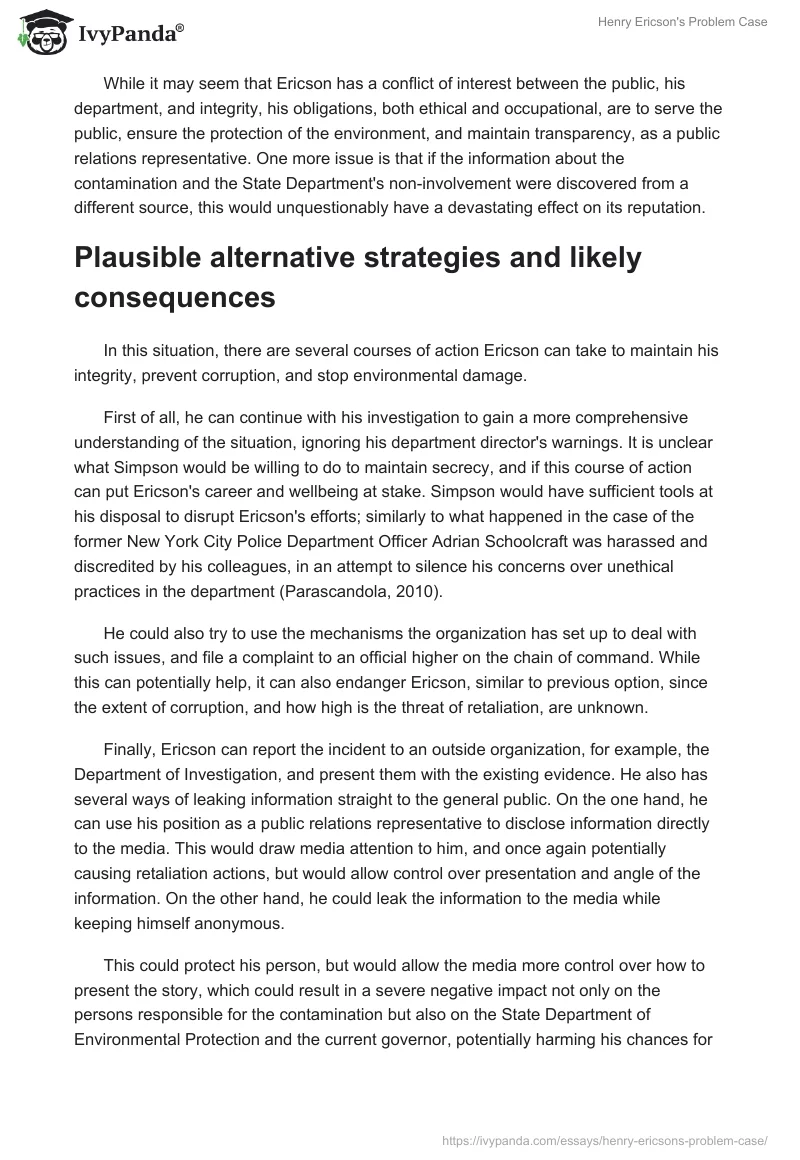An appraisal of the situation
The situation faced by Henry Erickson is complex and multi-faceted. Department director Mark Simpson, who is also responsible for Ericson being appointed to his current position, presents information to him in a way, as to create a one-sided dilemma, where on the one hand is the welfare of a single rancher and his herd, and, on the other, the integrity of a major business, which has many influential politicians and officials investing in with it, including those who support the current governor (who began focusing on the policy of the “open government” in the first place), the potential future governor, and Simpson himself. By extension, he is trying to imply that political damage to him can have an adverse impact on Erickson as well, creating a personal stake in maintaining silence.
However, Simpson’s presentation of the situation is biased, and omits or distorts important information. In the beginning, Erickson’s uncertainty stemmed from the lack of evidence confirming the connection between the livestock deaths, the Fast Grow Corporation, and Fitzgerald. But Simpson verified the existence of such a link and alluded to the damage the reveal of information could cause to the people involved, reinforcing the possibility of its illegal nature. Additionally, the involvement of Democrats and financial supporters of the governor does not automatically make him complicit with their misdemeanors.
In his actions, Simpson goes against such Principles of Public Administration, as defined by the European Commission in 2014, such as accountability, quality service, and public service. Also, both data discovered by Ericson and that which was shared by Simpson point to massive levels of corruption among politicians, as well as the attorney general, who not only ignore potential contamination problems but make effort to hide them.
Finally, Ericson needs to understand that if actual fertilizer contamination is taking place, this could endanger a lot of people beyond Oscar Walton and his cattle.
While it may seem that Ericson has a conflict of interest between the public, his department, and integrity, his obligations, both ethical and occupational, are to serve the public, ensure the protection of the environment, and maintain transparency, as a public relations representative. One more issue is that if the information about the contamination and the State Department’s non-involvement were discovered from a different source, this would unquestionably have a devastating effect on its reputation.
Plausible alternative strategies and likely consequences
In this situation, there are several courses of action Ericson can take to maintain his integrity, prevent corruption, and stop environmental damage.
First of all, he can continue with his investigation to gain a more comprehensive understanding of the situation, ignoring his department director’s warnings. It is unclear what Simpson would be willing to do to maintain secrecy, and if this course of action can put Ericson’s career and wellbeing at stake. Simpson would have sufficient tools at his disposal to disrupt Ericson’s efforts; similarly to what happened in the case of the former New York City Police Department Officer Adrian Schoolcraft was harassed and discredited by his colleagues, in an attempt to silence his concerns over unethical practices in the department (Parascandola, 2010).
He could also try to use the mechanisms the organization has set up to deal with such issues, and file a complaint to an official higher on the chain of command. While this can potentially help, it can also endanger Ericson, similar to previous option, since the extent of corruption, and how high is the threat of retaliation, are unknown.
Finally, Ericson can report the incident to an outside organization, for example, the Department of Investigation, and present them with the existing evidence. He also has several ways of leaking information straight to the general public. On the one hand, he can use his position as a public relations representative to disclose information directly to the media. This would draw media attention to him, and once again potentially causing retaliation actions, but would allow control over presentation and angle of the information. On the other hand, he could leak the information to the media while keeping himself anonymous.
This could protect his person, but would allow the media more control over how to present the story, which could result in a severe negative impact not only on the persons responsible for the contamination but also on the State Department of Environmental Protection and the current governor, potentially harming his chances for reelection. Additionally, his involvement could still be discovered by the adversaries involved due to prior interest in the case.
Choice of action and strategy, a justification of your choices
In this situation, the best course of action would be to use several methods. I would use the internal department’s mechanisms, and would attempt to coordinate with my superiors to produce the best message for the public and the media. It would draw attention to the issue, while also emphasizing that the discovery of this environmental problem and behind-the-scenes corruption was possible mainly due to the current governors “open government” policy.
This would prevent potential displaced criticism, and could even eventually help him in his election campaign. The message should also focus on the positive role of the Department in the discovery of this issue. If the findings of possible internal and external are presented as a “success” of the department, this could boost its reputation, and demonstrate the state officials’ striving for transparency. The latter factor could further strengthen the trust between the State Department and the public.
References
Parascandola, R. (2010). Whistleblower cop on lawsuit vs. NYPD: ‘This is not about money’. Web.


